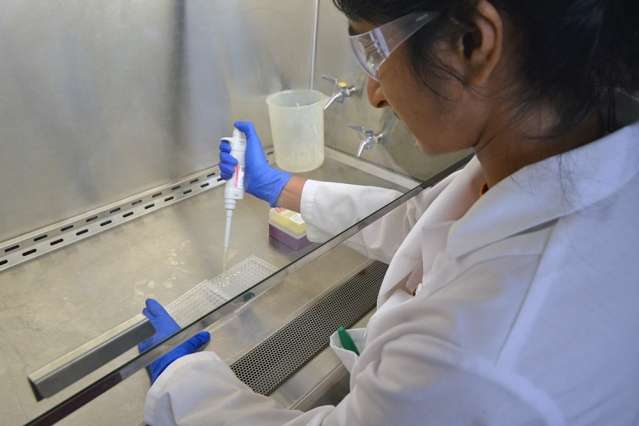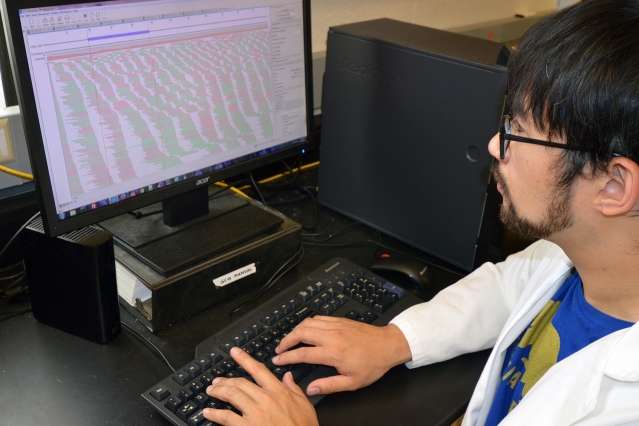Researchers prove fast microbial evolutionary bursts exist

There are more than a dozen species of finch that evolved on the Galapagos Islands, each identified by beak shape and size. Some have strong beaks to crack nuts while others have long, fine beaks to grasp larvae with surgical precision. All of the finches evolved from a common ancestor in a very short period of time, an evolutionary process known as adaptive radiation.
Although this burst of adaptive radiation is common for animals and plants, it has remained elusive and difficult to document in microbes in the wild—until now.
A new study published today in the journal Nature Communications and led by researchers from the MIT Department of Civil and Environmental Engineering (CEE) shows that adaptive radiation does exist in microbes. The discovery could portend new applications that create more economical and renewable biofuels, or innovate biomedical chemicals and products.
"Many people doubted it should be possible in contemporary environments since microbes have co-evolved with ecosystems on the planet for billions of years, so that most ecological opportunities might have been taken advantage of," says CEE Professor Martin Polz. "We demonstrated adaptive radiations do happen, and that they can lead to a rapid diversification of a single species into multiple, differentially adapted species."
Lead authors working under the supervision of Polz and Eric Alm, a professor in CEE and the MIT Department of Biological Engineering, included graduate student Philip Arevalo, former postdoc Jan-Hendrik Hehemann, and postdoc Manoshi Datta, all of CEE. Other contributors included current and former CEE postdocs Christopher H. Corzett, Andreas Henschel and former CEE graduate student Sarah P. Preheim; Sonia Timberlake of the Department of Biological Engineering; and Xiaoqian Yu of the MIT Department of Biology.
Microbial adaptation
"We were able to reveal the evolution of different ways the bacteria consume alginate, an important carbohydrate from kelp," says Hehemann, who sought a postdoc appointment within MIT's Department of Civil and Environmental Engineering precisely to explore this question of how microbes adapt to different resource use.
Hehemann, now a group leader at the Max Planck Institute for Marine Microbiology in Germany, is a biochemist by training as well as a structural biologist. He found that closely related populations of bacteria had very different sets of enzymes, suggesting they had different feeding strategies. Like the beaks of Darwin's finches, these enzymes allow the bacteria to most efficiently consume a narrow set of resources derived from kelp.
"Microbial diversity is so vast, which is why it remains a major challenge to understand how they all fit into this world. However, our work shows that resources might be partitioned at much finer scales than we previously thought," he says, adding: "This may be part of the puzzle why there are so many microbial species."

Datta helped bridge Hehemann's lab work with Arevalo's computation analysis, which fit well with her background in microbiology and specialization in computational biology.
"One of the unique and powerful aspects of this project is that we were able to generate a hypothesis by looking at bacterial genomic data, test their metabolic capabilities in the lab, and then go back to the genomes to see how these traits evolved," she says.
Gene transfers
Researchers have been able to sequence bacterial genome for the last two decades, but now the process has become routine as costs and analysis time have dropped significantly—from years and millions of dollars to perform to now under $100 and just a few hours.
Arevalo explains that the team looked at hundreds of Vibrionaceae strains whose full genomes were genetically sequenced: "What I was doing was computational—finding how the microbes adapted to different forms on the algae, and then looking at the history of these microbial genes."
Through this analysis, the researchers found that horizontal gene transfer, not point mutation, was the primary diversification driver. Horizontal gene transfer is a process by which an organism receives genetic material from a source other than its parent (e.g., from neighboring cells or the surrounding environment). In principle, this could occur through numerous mechanisms, and can transfer genes among organisms that are not closely related.
"It's very common to have gene duplication in bacteria, presumably to be able to synthesize a particular enzyme faster," Polz explains. "This research shows, however, that these bacteria duplicate not just one copy in the same genome, but instead acquire a new copy of the same functional gene by horizontal gene transfer from one microorganism to another. This differentiation tells us how selection in the environment works to create different types of organisms that either work together when degrading a substrate or compete when seeking nourishment."
Polz adds that some "pioneer" microbes partially degrade the algae substrate by releasing enzymes to make it more soluble, and then other bacteria come in and degrade it more.
"It takes a village," he says.
"This paper is part of the exemplary series of studies in microbial evolutionary diversification which put the Alm and Polz labs miles ahead of their competitors," says Professor W. Ford Doolittle, an evolutionary microbiologist at Dalhousie University in Canada who was not involved in the research. "Particularly intriguing is that it is gene transfer, not duplication, that is the operative process, reinforcing our appreciation of bacterial communities as highly interactive at the genetic—as well as the metabolic—level."
More information: Jan-Hendrik Hehemann et al. Adaptive radiation by waves of gene transfer leads to fine-scale resource partitioning in marine microbes, Nature Communications (2016). DOI: 10.1038/ncomms12860
Journal information: Nature Communications
Provided by Massachusetts Institute of Technology
This story is republished courtesy of MIT News (web.mit.edu/newsoffice/), a popular site that covers news about MIT research, innovation and teaching.




















